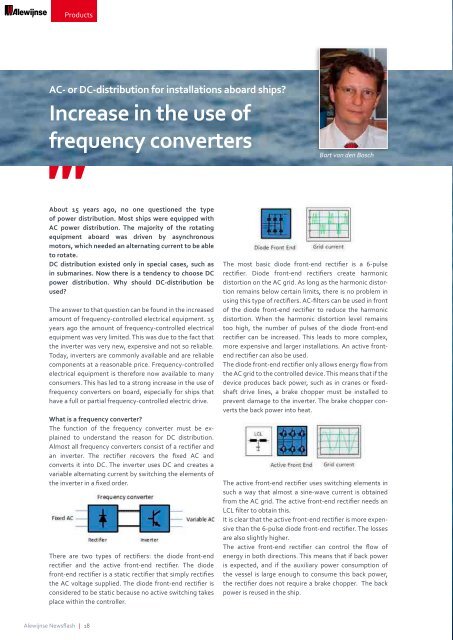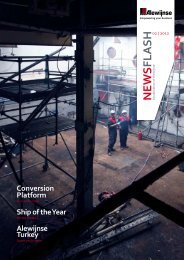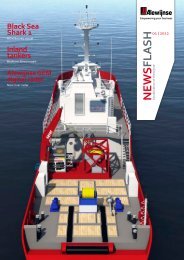N EWS FLASH - Alewijnse
N EWS FLASH - Alewijnse
N EWS FLASH - Alewijnse
Create successful ePaper yourself
Turn your PDF publications into a flip-book with our unique Google optimized e-Paper software.
Products<br />
Products<br />
AC- or DC-distribution for installations aboard ships<br />
Increase in the use of<br />
frequency converters<br />
About 15 years ago, no one questioned the type<br />
of power distribution. Most ships were equipped with<br />
AC power distribution. The majority of the rotating<br />
equipment aboard was driven by asynchronous<br />
motors, which needed an alternating current to be able<br />
to rotate.<br />
DC distribution existed only in special cases, such as<br />
in submarines. Now there is a tendency to choose DC<br />
power distribution. Why should DC-distribution be<br />
used<br />
The answer to that question can be found in the increased<br />
amount of frequency-controlled electrical equipment. 15<br />
years ago the amount of frequency-controlled electrical<br />
equipment was very limited. This was due to the fact that<br />
the inverter was very new, expensive and not so reliable.<br />
Today, inverters are commonly available and are reliable<br />
components at a reasonable price. Frequency-controlled<br />
electrical equipment is therefore now available to many<br />
consumers. This has led to a strong increase in the use of<br />
frequency converters on board, especially for ships that<br />
have a full or partial frequency-controlled electric drive.<br />
What is a frequency converter<br />
The function of the frequency converter must be explained<br />
to understand the reason for DC distribution.<br />
Almost all frequency converters consist of a rectifier and<br />
an inverter. The rectifier recovers the fixed AC and<br />
converts it into DC. The inverter uses DC and creates a<br />
variable alternating current by switching the elements of<br />
the inverter in a fixed order.<br />
There are two types of rectifiers: the diode front-end<br />
rectifier and the active front-end rectifier. The diode<br />
front-end rectifier is a static rectifier that simply rectifies<br />
the AC voltage supplied. The diode front-end rectifier is<br />
considered to be static because no active switching takes<br />
place within the controller.<br />
<strong>Alewijnse</strong> Newsflash | 18<br />
Bart van den Bosch<br />
The most basic diode front-end rectifier is a 6-pulse<br />
rectifier. Diode front-end rectifiers create harmonic<br />
distortion on the AC grid. As long as the harmonic distortion<br />
remains below certain limits, there is no problem in<br />
using this type of rectifiers. AC-filters can be used in front<br />
of the diode front-end rectifier to reduce the harmonic<br />
distortion. When the harmonic distortion level remains<br />
too high, the number of pulses of the diode front-end<br />
rectifier can be increased. This leads to more complex,<br />
more expensive and larger installations. An active frontend<br />
rectifier can also be used.<br />
The diode front-end rectifier only allows energy flow from<br />
the AC grid to the controlled device. This means that if the<br />
device produces back power, such as in cranes or fixedshaft<br />
drive lines, a brake chopper must be installed to<br />
prevent damage to the inverter. The brake chopper converts<br />
the back power into heat.<br />
The active front-end rectifier uses switching elements in<br />
such a way that almost a sine-wave current is obtained<br />
from the AC grid. The active front-end rectifier needs an<br />
LCL filter to obtain this.<br />
It is clear that the active front-end rectifier is more expensive<br />
than the 6-pulse diode front-end rectifier. The losses<br />
are also slightly higher.<br />
The active front-end rectifier can control the flow of<br />
energy in both directions. This means that if back power<br />
is expected, and if the auxiliary power consumption of<br />
the vessel is large enough to consume this back power,<br />
the rectifier does not require a brake chopper. The back<br />
power is reused in the ship.<br />
Since 12-pulse or higher pulse rectifiers lead to more<br />
complex systems with transformers that have more<br />
volume, weight and cost compared with active front-end<br />
rectifiers, they are not considered as attractive alternatives.<br />
The inverter is in principle the same as an active front-end<br />
rectifier without the LCL-filter. The inverter creates a variable<br />
frequency and voltage so that the electric motor will<br />
rotate at the desired speed.<br />
When do you apply DC-distribution<br />
DC-distribution makes the use of standard inverters<br />
possible without the large filters. Furthermore, DCdistribution<br />
makes back power exchange possible and<br />
thereby reduces the need for brake choppers. Other positive<br />
effects of DC-distribution are: no problems with<br />
harmonic current and achieving almost unity power<br />
factor.<br />
Can we conclude that DC-distribution is always the best<br />
solution for a full or partial frequency regulated electric<br />
drive The answer to that question is no.<br />
The DC power has to be created. Standard auxiliary ship’s<br />
generators produce alternating current, so a rectifier is<br />
required between the generator and the DC-distribution<br />
in order to produce DC power. As with the frequency<br />
converter, this rectifier can be a diode front-end rectifier<br />
or active front-end rectifier. If the frequency-regulated<br />
electrical equipment draws about the same amount of<br />
current as the current generated, there will be no advantage<br />
in installation costs or volume. However, if the ship<br />
contains frequency-regulated electrical equipment that is<br />
not in simultaneous use, a gain in volume and investment<br />
can be expected. In that case, the same active front-end<br />
rectifier is used for several inverters.<br />
Another reason to use DC-distribution is when variablespeed<br />
auxiliary generators are used. Variable-speed<br />
generators deliver alternating current, but not at a fixed<br />
frequency. As a result, the auxiliary diesel engine can run<br />
at its optimum working speed, which leads to a better<br />
efficiency. Depending on the brand and type of diesel<br />
engine, an improvement of up to 6% can be achieved. The<br />
auxiliary diesel engine can often supply more power from<br />
the same engine, since most engines are not designed for<br />
generator operation, requiring a fixed speed (usually 1500<br />
or 1800 rpm), but as a drive (for example, a speed range<br />
between 600 and 2200 rpm).<br />
If DC distribution is used, the AC generators do not require<br />
synchronization. The converter between the AC generator<br />
and DC distribution will adapt to the DC power supply.<br />
If the voltage is at the correct level, the generator can be<br />
connected to the distribution system. Since the converter<br />
is very fast, this will happen even before the auxiliary<br />
diesel engine is running at normal speed.<br />
The frequency freedom for the auxiliary generators is<br />
more than welcome for LNG powered auxiliary engines.<br />
The reason is that LNG powered auxiliary engines have<br />
poor dynamic response to load steps and can reduce in<br />
speed faster than the allowable frequency decrease of the<br />
AC net.<br />
DC-distribution should be considered when the ship’s<br />
distribution system needs a battery for energy storage.<br />
Battery systems can either be connected directly to the<br />
ship’s distribution system, or via a converter. When<br />
connected directly to the ship’s batteries, the ship’s<br />
distribution system must be DC. In other cases, both<br />
direct and alternating current can be considered.<br />
Technical problems with DC distribution<br />
As described above, DC power distribution has a number<br />
of advantages. However, it also has some disadvantages.<br />
Although most electrical power is consumed as DC, the<br />
rest of the ship is still needs AC power, for which converters<br />
are needed. The required AC supply is produced<br />
electronically by the static converter. Normally, two are<br />
required for redundancy. This is necessary to ensure the<br />
energy supply to vital equipment.<br />
Both static converters operate simultaneously and can<br />
work in parallel. However, this is not recommended. If a<br />
short circuit occurs on the AC network, the di/dt can<br />
increase to the point where both static converters are<br />
disabled, even if the maximum converter current has<br />
not been reached yet. Therefore the converters should<br />
be connected to isolated AC nets. This does not apply if<br />
rotating-converters are applied.<br />
Another problem is the calculation of the short-circuit<br />
levels of the DC distribution.<br />
At present, the classification bodies offer no directive<br />
on the calculation of short circuit levels for DC systems.<br />
Lloyds is currently working on guidelines.<br />
Further calculation of the DC short-circuit current is not<br />
as easy as for AC distribution. This is mainly due to the<br />
capacitors in the converters connected to the DC distribution<br />
system and the very low resistance of the DC<br />
distribution system. The DC voltage in combination with<br />
the very low-resistance leads to high short-circuit<br />
currents.<br />
<strong>Alewijnse</strong> uses a simulation program for the correct calculation<br />
of short circuit. The calculation of a short circuit<br />
is used to prove that the DC distribution system is strong<br />
enough to withstand short circuits.<br />
Conclusion<br />
As an alternative to AC distribution, DC distribution can<br />
in certain circumstances offer significant advantages with<br />
regard to lower investment and higher efficiency. This is<br />
especially interesting for ships with frequency-controlled<br />
electrical equipment. The design of a reliable and efficient<br />
DC distribution system requires extensive calculation and<br />
an understanding of the electrical system. Based on experience<br />
with AC and DC distribution systems, <strong>Alewijnse</strong> can<br />
help you to find the best electrical solution to meet your<br />
specific needs and wishes.<br />
19 | <strong>Alewijnse</strong> Newsflash









